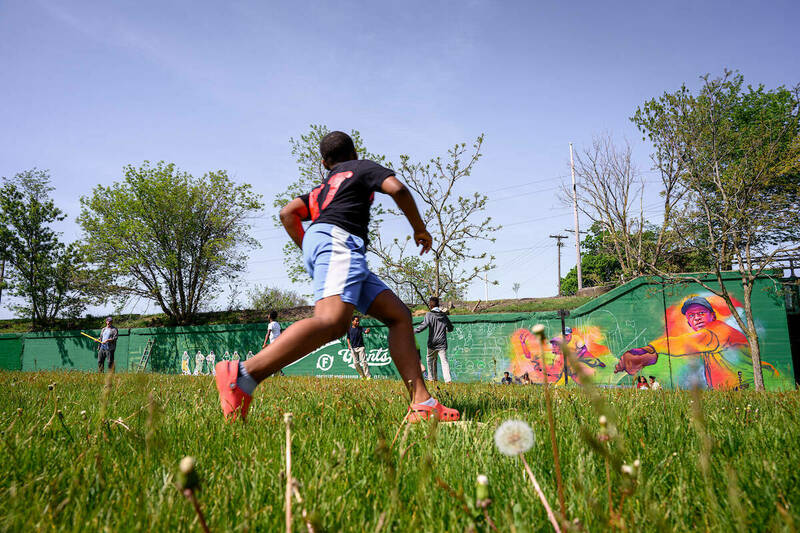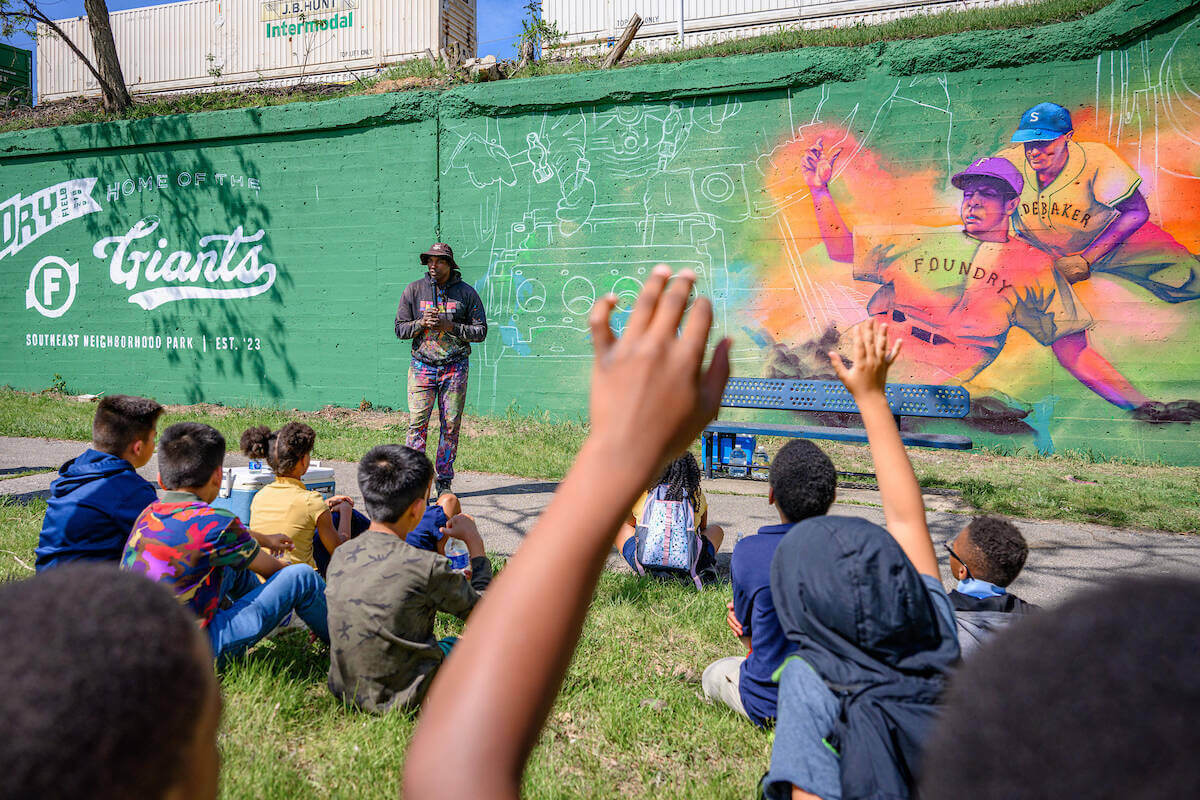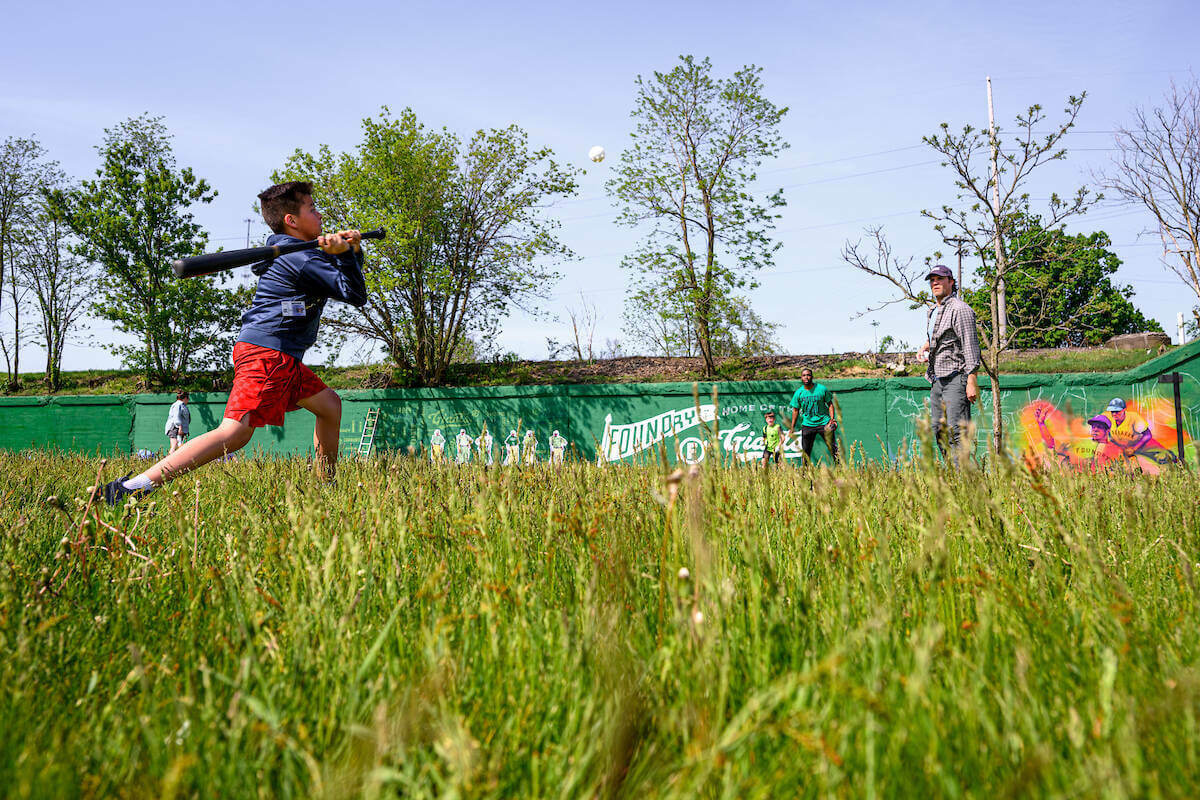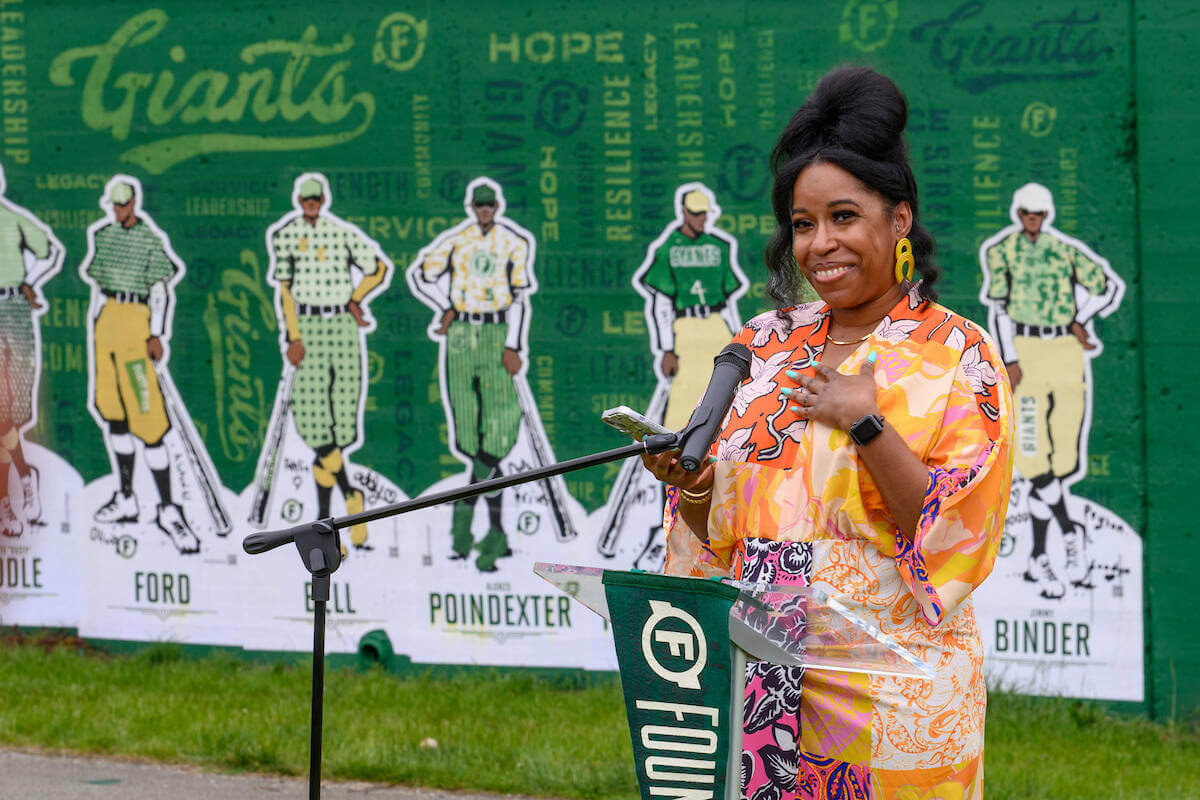 Circling the bases at Foundry Field, where the past is present on the left field wall. Photography by Matt Cashore ’94
Circling the bases at Foundry Field, where the past is present on the left field wall. Photography by Matt Cashore ’94
South Bend, Indiana
May 12, 2023
The heavy sky threatens as we gather in the far corner of grass at Southeast Community Park, standing in what is officially — as of today — center field of Foundry Field, Home of the Giants. We collectively will the rain away like ballplayers ourselves.
Beside me, Seabe Gavin Jr., athletic director at Riley High School, has tears in his eyes. “I get emotional thinking about it, man,” he says. His father, Seabe Sr., never talked about whether he was a good athlete. He only talked about doing your best, not taking your opportunities for granted. “When I was 13, I wanted to quit football, and my dad said, ‘OK, but if you quit football you’re quitting everything else, too.’” Gavin didn’t understand. “My dad told me, ‘Too many people fought to give you the right to play, to give people like me and your mom the chance to vote, so we don’t quit.’ That’s just how he carried himself.”
Around us, the community gathers en masse. The mayor of South Bend is here, and so are dozens from the neighborhood, as well as the leadership of the Southeast Organized Area Residents. Members of the Sappy Moffitt Field Foundation — an extension of the local adult rec league where the idea for the field originated — set up folding chairs and collapsible rain shelters. The South Bend parks department hooks up a public address system. The Riley High School baseball team strolls down in their uniforms. Children bounce over from the Boys & Girls Club and ham it up for the television cameras, pure glee.
“We live in a world now,” Gavin tells me, “where in some states you can’t even talk about Black history anymore. But here in the state of Indiana we can still talk about it.”

For today’s occasion, Gavin wears a neat pinstriped jersey that collects the logos of all the famed Negro League teams — the Kansas City Monarchs, the Birmingham Black Barons, to name a couple who once barnstormed in South Bend, drawing huge crowds to the Studebaker Company’s long-gone Lippincott Park. Gavin’s father had played in that ballpark, too, a famed slugger for a local team called the Giants, the Black baseball club that existed in various, interconnected incarnations from 1916 (or so) to 1940 (or so).
This history — the namesake of the field — is being celebrated with the unveiling of the first Foundry Field mural, right there, tall and bright, on the retaining wall of the train tracks — i.e. the left field fence. The mural, and its arresting neon palette, is the work of Thomas “Detour” Evans, an artist from Denver, whose visit to South Bend was made possible with support from Notre Dame’s Center for Social Concerns.
All week, Detour put in dawn-to-dusk workdays, painting, while children from the Boys & Girls club and design students of Notre Dame professor Clinton Carlson, a core Sappy Moffitt Field Foundation member, visited with him and learned about his process and artwork. The mural itself is all greens, pinks, blues and purples, and it depicts the Foundry Giants, the 1920s-era of the team, comprised of foundry workers from Studebaker.
The children and Notre Dame students had worked together this week on posters of historic Giant ballplayers, each of which were now pasted onto the wall beside Detour’s painting. In the mural, John “Big Pitch” Williams, a South Bend native who also pitched for the St. Louis Stars, stands tall in his windup. Alonzo Poindexter, who’d come to South Bend during the Great Migration, slides safely in a cloud of dust. Around the players we see the shadows of automotive engines, foundry buildings — our city’s industrial past.

More than a dozen of Alonzo Poindexter’s descendants are here today, a joyful turn of events, as they’d heard their forebear’s name in a news report about the field only a week or two ago and were surprised to learn he’d been a ballplayer. And that’s exactly how the field is intended to work, Mike Hebbeler told me. Hebbeler is a cofounder of the Sappy Moffitt League and an educator and administrator in the Center of Social Concerns, where he’s heavily involved in their Arts of Dignity programming. Yes, this is a baseball field, he said, where kids and others will have the opportunity to play a game, “but it’s also meant to be a collection of previously untold stories.” Detour told me he’s hoping the mural inspires folks to bring out those forgotten photos and newspaper clippings that might be hiding in attic boxes.
Alonzo Poindexter ended up in the mural in large part due to research conducted by undergraduate students in Notre Dame professor Katherine Walden’s Baseball & America course. Marc Barnes, a graduating senior from New Orleans who had specifically researched Alonzo Poindexter, is here, too, speaking with the Poindexter family. When I catch him for a minute he describes the surreal nature of it, a grin on his face. “You do a lot of assignments in college that nobody ever sees, just because you just have to. But to know you’ve done one that actually means something to others, and now to meet them in person? It’s special.”
The program begins with Hebbeler’s remembrance of Jay Caponigro ’91, a beloved community organizer and Sappy Moffitt ballplayer who had an immeasurable impact on neighborhoods all over South Bend. Jay, days before, passed away after a year-long battle with cancer. “Jay was close to many of us here, and he loved this project,” Hebbeler says. “He’s here in spirit, and I thought we might pause for a moment to honor him. I’ve got his Sappy Moffitt hat right here.”
Among the speakers to follow is Lenisha Lipsey, great-great granddaughter of Alonzo Poindexter. She tells us about Alonzo’s life, how he’d fought in World War I and worked in the coal mines of Kentucky before coming to South Bend and working at Studebaker. Later, in 1941, he’d become one of St. Joseph County’s first Black deputy sheriffs, a role he served in for at least 23 years. He died in 1977, and Lipsey describes the ways in which his example and “his dedication to service” lives on through his family. She says that this project, Foundry Field, “has the potential to bridge gaps of past, present, and future . . . to provide the youth of today with a lens to South Bend’s rich baseball history and examples of community pillars” like Alonzo Poindexter. It’s important, she notes, for children to see in those examples faces that look like their own. Public art can do this, while inviting all of us to learn as well.

A train rolls by and the crowd shouts, on the count of three, “Play ball!” to conclude the programming. Now we’re hanging out, socializing. Foundry Field pennants and T-shirts are handed out. The children show off their posters on the wall, which they’ve signed. Jacqueline Kronk, CEO of the Boys & Girls Club, called the kids “the most important people here today,” the individuals who will build the future on the legacy of families like the Poindexters.
I’m thinking about something said to me by Juhan Taylor, a Riley High School senior and artist who assisted Detour in his work this week. Taylor is headed to college on a scholarship next year, and it meant a lot to him, he said, knowing there would be something beautiful here on this wall that he had worked on, that he could bring friends and family to see.
Over at the mural of the Foundry Giants, now, the Poindexters are gathering for a photo beneath the enormous figure of Alonzo, the patriarch of their family. “This right here,” Detour told me earlier this week, nodding to his work in progress, “is a way of saying to someone, You’re an important part of this town and its history.”
The family smiles in the flash of the camera. The rain never comes.
Nicholas Mainieri serves as the transition program director in academic services for student-athletes at Notre Dame and is the author of a novel, The Infinite.